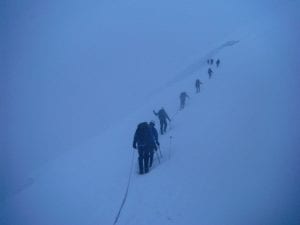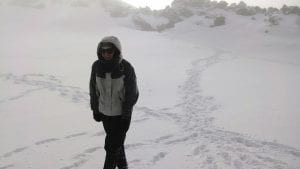i love summer.
and in the summer we climb mountains.
Or I did one time--ohh yes that one time--in 2014.
After midnight on my 29th birthday, I awoke shivering in a tiny tube-tent at Camp Muir, a Mount Rainier base camp. It was beyond Paradise.
Under the moon, we roped up and climbed across the Ridge toward the Cleaver with twenty-plus headlamps lighting our ice-packed path. Just a little bit of high alpine travel and crevasse rescue practice. In the middle of the night. At 10,500 feet elevation. No problem.
One month later, we did it all again and the culmination was even better. For an 11-hour round-trip jaunt — long for the average trek — it was a breeze. Except for the fact that climbing mountains is actually completely impossible.
Me, summit Mount Rainier? Who know what I'd been thinking.
I can’t, I thought at 11,000 feet, as my stomach heaved the squeezable apple sauce I’d just consumed right back up again. Feeling suddenly buoyant, I stole a camelbak, stuck that water tube in my mouth, and re-clipped my crampons. I absolutely couldn’t do it, but I had to.
Hours later and a couple thousand feet farther, I looked to the front of my rope line and then to the back. I leaned into my ice ax, not acknowledging the snow cliff to my left, and found myself explicitly trusting the three climbers I was harnessed to. I had to make sure every single one of my own footfalls was worthy of the trust they had placed in me.
At 14,000-ish feet we hit a morning storm. It cleared, so we didn’t turn back — even though this was our last chance. A couple hundred feet more. Total white out. Could barely see my rope line. Too exhausted to be terrified.
I have to get there, I thought. We have to get there.
Washington State’s Mount Rainier is what mountaineers call a 50/50 mountain; 50% of attempts are successful. Just over half of our original climbing team was successful that sunny June day.
At the top we rested for a short while, took some flattering pictures (see left), ate fruit, re-hydrated, and worried our feet would swell if we took off our boots. Twenty minutes later the peaks had cleared and we were in descent. And you know what?
Going down is TWICE as difficult.
After reaching the top, what is the joy in returning to the bottom? To anticipate the glory stories you’ll tell?
No way.
At the top a climber is too spent, too full of the mountain and their team. Everything has been given, and yet, the body-pounding, joint-fatigue of the journey down remains. With every weary step you move farther away from what you thought was your goal.
I have only met that particular summit once. That one perfect time. But it was reaching base camp again that taught me everything I’d ever need to know about believing I was incapable — physically, emotionally, spiritually, creatively — of finishing what I’d started. Mount Rainier showed me the worst lies I tell myself, about peaks and valleys and destinations, and broke them over her glorious lapidist knee.
I couldn’t do it, but I did it anyway. I hope to feel similarly about my writing one day.
The odds are probably 50/50.
Side note: I no longer eat anything squeezable.




